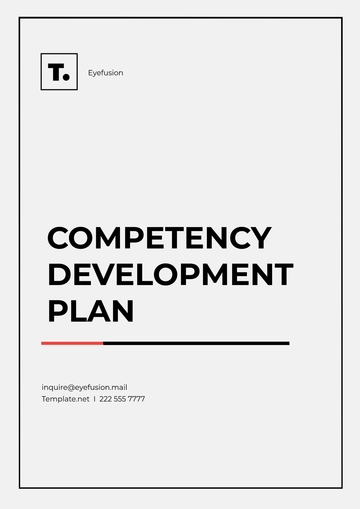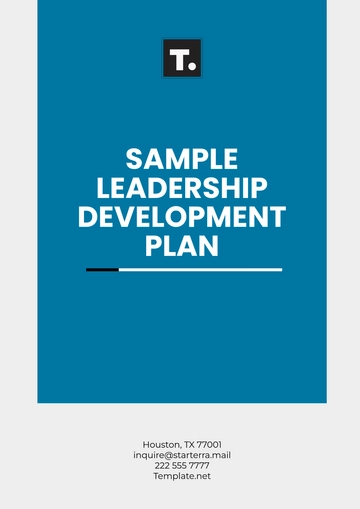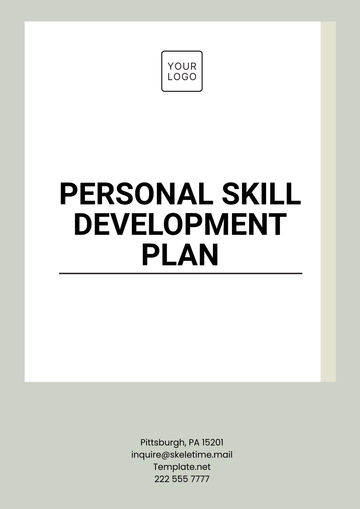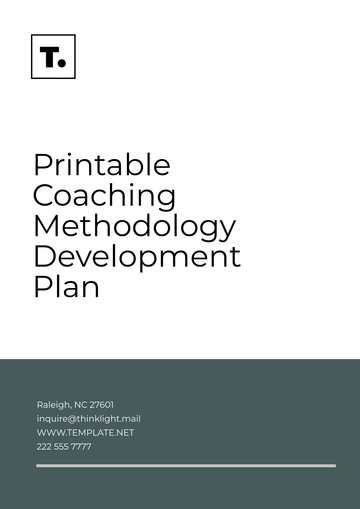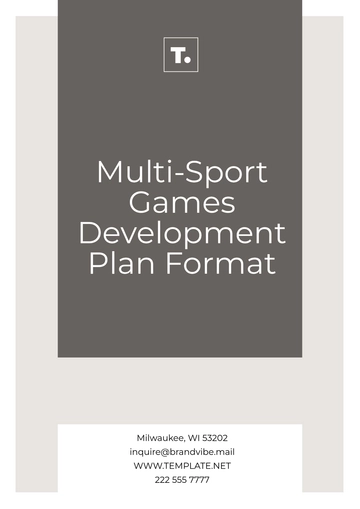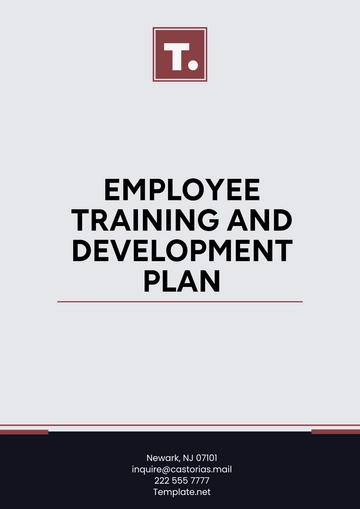Free Sales Training and Development Plan
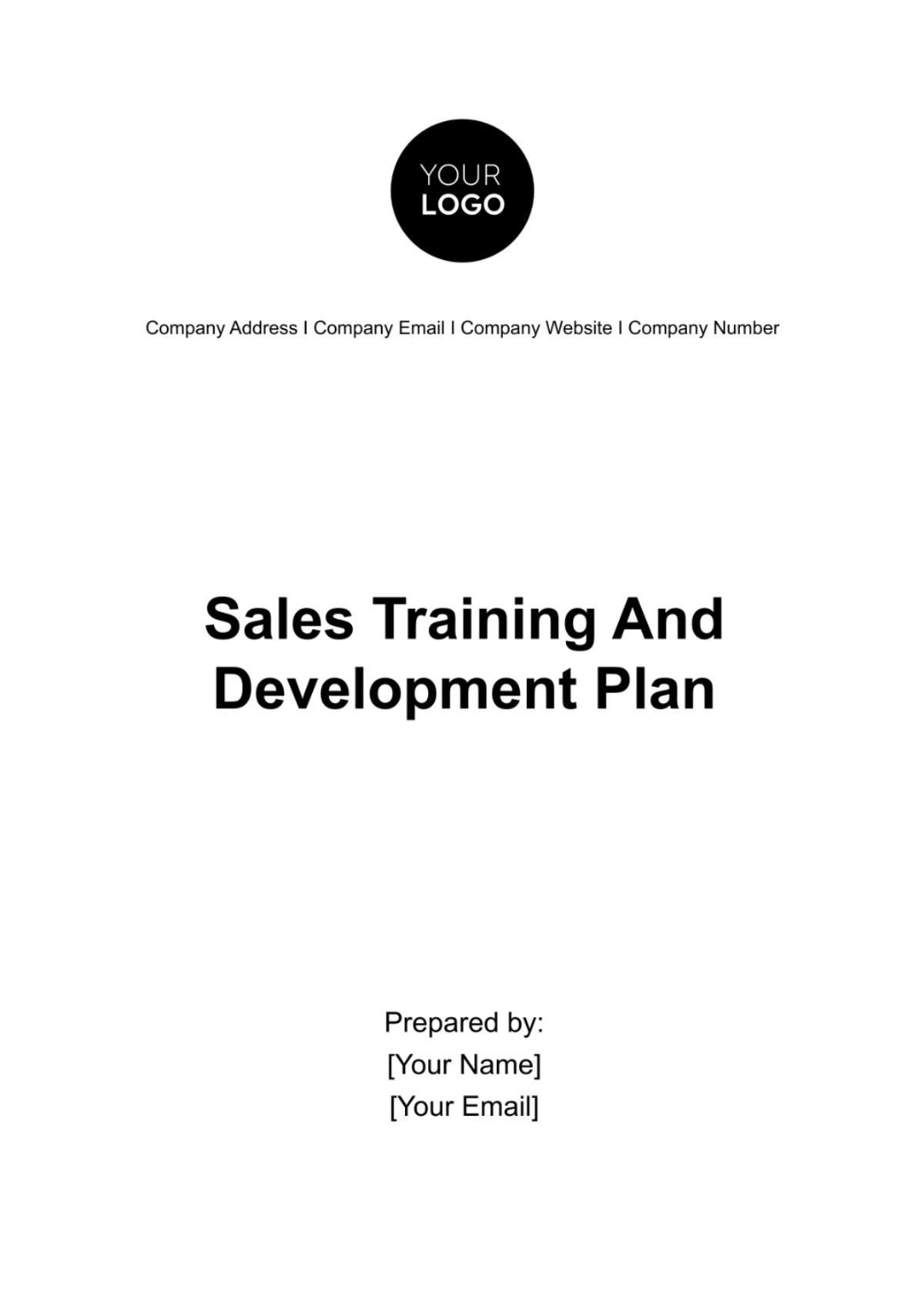
I. Introduction
A. Overview
Purpose
The purpose of the Sales Training and Development Plan is to equip our sales team with the necessary skills, knowledge, and tools to excel in their roles, thereby driving revenue growth and ensuring customer satisfaction. This comprehensive plan outlines the strategies and activities that will be implemented to enhance the performance and effectiveness of our sales force.
Scope
This plan encompasses all aspects of sales training and development within [Your Company Name], spanning across various departments and regions. It aims to address the specific needs and challenges faced by our sales team, including improving product knowledge, enhancing sales techniques, and strengthening customer relationship management skills.
B. Objectives
Increase Sales Performance
The primary objective of this training plan is to increase the overall sales performance of our team members. By providing targeted training and development opportunities, we aim to equip our sales professionals with the skills and strategies needed to achieve and exceed sales targets consistently.
Enhance Product Knowledge
Product knowledge is essential for effective sales communication and customer engagement. Through comprehensive training sessions and resources, we aim to enhance the product knowledge of our sales team, enabling them to articulate the features, benefits, and value propositions of our products and services confidently.
Improve Customer
Relationship Management Building strong and lasting relationships with customers is crucial for driving repeat business and fostering loyalty. This plan includes training modules focused on customer relationship management, covering topics such as active listening, empathy, and effective communication techniques to ensure positive interactions with customers at every touchpoint.
Strengthen Communication
Skills Effective communication is at the core of successful sales interactions. Our training program will include modules designed to strengthen various aspects of communication skills, including verbal and non-verbal communication, persuasion techniques, and negotiation strategies, to enable our sales team to convey messages effectively and influence purchasing decisions.
Foster Team
Collaboration Collaboration and teamwork are essential for maximizing sales effectiveness and leveraging the collective expertise of our sales force. Through team-building activities, collaborative projects, and peer learning opportunities, we aim to foster a culture of collaboration and support among our sales team members, enabling them to work together cohesively towards common goals.
II. Training Needs Assessment
A. Identify Training Needs
Sales Performance
Evaluation To identify specific areas for improvement, we will conduct a thorough evaluation of the sales performance metrics, including sales revenue, conversion rates, and customer acquisition costs. This analysis will help pinpoint areas where additional training and development efforts are needed to enhance performance and productivity.
Customer Feedback Analysis
Customer feedback is a valuable source of insight into the effectiveness of our sales efforts and the quality of customer interactions. We will analyze customer feedback data, including surveys, reviews, and complaints, to identify recurring themes, pain points, and areas for improvement in our sales processes and customer engagement strategies.
Skill Gap Analysis
A skill gap analysis will be conducted to assess the current proficiency levels of our sales team members against the desired skillset for their roles. This analysis will help identify areas where additional training and development interventions are needed to bridge the gap between current and desired skill levels, ensuring that our sales team is equipped to meet evolving market demands and customer expectations.
Market Trends Research
Staying abreast of market trends, industry developments, and competitive landscape is essential for effective sales performance. We will conduct ongoing research and analysis of market trends, customer preferences, and competitor strategies to identify emerging opportunities and challenges that may impact our sales efforts. This insight will inform the development of targeted training programs and sales strategies to capitalize on market opportunities and stay ahead of the competition.
III. Training Strategies
A. Training Methods
Classroom Training
Description: Instructor-led training sessions conducted in a classroom setting, allowing for interactive learning, group discussions, and hands-on activities.
Target Audience: All sales team members, including new hires and experienced professionals.
Frequency: Quarterly training sessions, with topics aligned with organizational priorities and sales objectives.
Resources Required: Training facilities, audiovisual equipment, training materials, and qualified instructors.
On-the-Job Training
Description: Practical, experiential learning conducted in real-world sales scenarios, allowing sales team members to apply theoretical knowledge in practical situations.
Target Audience: New hires and junior sales representatives, as well as those seeking to develop specific skills or overcome challenges in their roles.
Frequency: Ongoing, integrated into daily sales activities and supervised by experienced sales managers or mentors.
Resources Required: Access to sales tools and systems, coaching and feedback mechanisms, and mentorship resources.
Online Learning Modules
Description: Self-paced, interactive e-learning modules accessible via an online learning management system (LMS), covering various sales topics and skills.
Target Audience: All sales team members, offering flexibility for remote learning and personalized development paths.
Frequency: Continuous availability, with new modules released periodically to address emerging training needs and skill gaps.
Resources Required: Access to the LMS platform, content development tools, and technical support for learners.
Role-Playing Exercises
Description: Simulation-based exercises where sales team members role-play different sales scenarios, allowing them to practice communication, objection handling, and negotiation skills in a safe environment.
Target Audience: All sales team members, particularly those seeking to improve their interpersonal skills and sales techniques.
Frequency: Integrated into regular training sessions and workshops, with opportunities for feedback and reflection.
Resources Required: Facilitators to lead role-playing sessions, scenario scripts, and debriefing guidelines.
Mentorship Programs
Description: Formal or informal mentorship relationships established between experienced sales professionals (mentors) and less experienced team members (mentees), providing guidance, support, and career development opportunities.
Target Audience: New hires, junior sales representatives, and individuals looking to advance their careers within the organization.
Frequency: Ongoing mentorship meetings and check-ins, supplemented by structured mentoring programs and resources.
Resources Required: Mentorship training for mentors, program guidelines, and support resources for mentees.
B. Training Content
Product Knowledge
Description: Training sessions focused on educating sales team members about the features, benefits, and unique selling points of [Your Company Name]'s products and services.
Learning Objectives:
Understand the key features and functionalities of each product.
Articulate the value proposition and competitive advantages of our products.
Address common customer questions, objections, and concerns effectively.
Delivery Methods: Classroom training, online modules, product demonstrations, and hands-on experience.
Sales Techniques
Description: Training modules designed to enhance the sales skills and techniques of our team members, covering areas such as prospecting, qualifying leads, presenting solutions, and closing deals.
Learning Objectives:
Develop effective prospecting strategies to identify and engage potential customers.
Master the art of consultative selling, focusing on understanding customer needs and providing tailored solutions.
Utilize persuasive communication techniques and objection handling strategies to overcome customer resistance and objections.
Delivery Methods: Role-playing exercises, case studies, sales simulations, and real-world sales scenarios.
Customer Relationship Management
Description: Training programs aimed at improving the customer relationship management skills of our sales team members, emphasizing the importance of building rapport, trust, and long-term partnerships with customers.
Learning Objectives:
Enhance active listening skills to understand customer needs and preferences.
Develop empathy and emotional intelligence to connect with customers on a personal level.
Implement effective communication strategies for building and maintaining positive customer relationships.
Delivery Methods: Role-playing exercises, customer interaction simulations, communication workshops, and feedback sessions.
Negotiation Skills
Description: Training sessions focused on equipping sales professionals with the negotiation skills and strategies needed to achieve mutually beneficial outcomes in sales negotiations.
Learning Objectives:
Understand the principles of negotiation and the importance of preparation and planning.
Learn effective negotiation techniques, including framing, anchoring, and concession management.
Practice negotiation scenarios to develop confidence and agility in handling different negotiation styles and situations.
Delivery Methods: Role-playing exercises, negotiation simulations, case studies, and expert-led workshops.
Time Management
Description: Training modules aimed at helping sales team members prioritize tasks, manage their time effectively, and maximize productivity in a fast-paced sales environment.
Learning Objectives:
Identify key priorities and high-value activities to focus on.
Implement time management techniques and tools for planning, organizing, and prioritizing tasks.
Develop strategies for minimizing distractions, managing interruptions, and maintaining work-life balance.
Delivery Methods: Time management workshops, productivity tools and resources, goal-setting exercises, and personalized coaching sessions.
IV. Implementation Plan
A. Resource Allocation
Budget Allocation: [$00,000]
Description: Allocate a specific budget for the implementation of the sales training and development plan, covering expenses related to training materials, instructor fees, venue rentals, and other associated costs.
Justification: Investing in training and development is essential for enhancing the skills and capabilities of our sales team, ultimately leading to improved sales performance and business growth.
Training Facilities: [Specify Locations]
Description: Identify suitable training venues, such as conference rooms, training centers, or virtual meeting platforms, to conduct training sessions and workshops.
Justification: Providing appropriate training facilities ensures a conducive learning environment for our sales team members, allowing them to focus on learning and skill development.
Training Materials: [Specify Resources]
Description: Procure or develop training materials, including presentations, handouts, manuals, and online resources, to support the delivery of training programs and reinforce learning objectives.
Justification: Access to comprehensive training materials enhances the effectiveness of training sessions and provides reference materials for ongoing learning and development.
B. Stakeholder Engagement
Communication Plan
Description: Develop a communication plan to inform stakeholders, including sales team members, managers, and executives, about the objectives, scope, and timeline of the sales training and development plan.
Channels: Email announcements, team meetings, intranet updates, and newsletters.
Frequency: Regular updates throughout the implementation process to keep stakeholders informed and engaged.
Sales Team Involvement
Description: Involve sales team members in the planning and implementation of training initiatives by soliciting feedback, ideas, and suggestions for improving training programs and addressing specific learning needs.
Engagement Activities: Surveys, focus groups, brainstorming sessions, and collaborative planning meetings.
Benefits: Fosters a sense of ownership and commitment among sales team members, leading to greater participation and buy-in for training initiatives.
Leadership Support
Description: Secure buy-in and support from senior leadership, including executives and department heads, for the sales training and development plan by highlighting the strategic importance of investing in employee development and talent management.
Engagement Activities: Presentations, executive briefings, and one-on-one meetings to communicate the business case for training and gain leadership endorsement.
Benefits: Demonstrates organizational commitment to employee development, encourages resource allocation, and reinforces the importance of training as a strategic priority.
C. Training Delivery
Coordination with Training Providers
Description: Coordinate with internal and external training providers, subject matter experts, and industry partners to develop and deliver high-quality training programs tailored to the specific needs of our sales team.
Activities: Vendor selection, contract negotiation, program customization, and scheduling of training sessions.
Benefits: Access to specialized expertise, diverse training resources, and innovative learning methodologies to enhance the effectiveness of training initiatives.
Internal Subject Matter Experts
Description: Identify and leverage internal subject matter experts within the organization, such as top-performing sales professionals, product specialists, and customer service representatives, to share knowledge, best practices, and real-world insights with the sales team.
Engagement Strategies: Expert-led workshops, peer-to-peer coaching, and knowledge-sharing sessions.
Benefits: Provides practical, relevant insights from experienced practitioners, fosters cross-functional collaboration, and promotes a culture of continuous learning and development.
Training Logistics and Administration
Description: Manage logistical aspects of training delivery, including scheduling training sessions, coordinating venue logistics, distributing training materials, and tracking attendance and participation.
Administrative Tasks: Event planning, resource coordination, communication with participants, and post-training evaluation and follow-up.
Tools and Resources: Training management software, event planning templates, and administrative support staff.
Benefits: Ensures smooth execution of training activities, minimizes disruptions, and maximizes the effectiveness of training investments by optimizing logistics and administration processes.
V. Monitoring and Evaluation
A. Key Performance Indicators (KPIs)
KPI | Description | Target |
|---|---|---|
Sales Revenue Growth | Percentage increase in sales revenue compared to the previous period | [10%] |
Customer Satisfaction Scores | Percentage of customers reporting high satisfaction levels with sales interactions | [90%] |
Training Participation Rates | Percentage of sales team members participating in scheduled training sessions | [95%] |
Employee Turnover Rates | Percentage of sales team turnover within a specified timeframe | [10%] |
B. Evaluation Methods
Pre and Post-Training Assessments
Description: Conduct pre-training assessments to gauge baseline knowledge and skill levels of sales team members, followed by post-training assessments to measure learning outcomes and improvements.
Tools: Pre and post-training quizzes, skills assessments, and performance evaluations.
Frequency: Administer assessments before and after each training program to track individual and collective progress over time.
Sales Performance Reviews
Description: Regular performance reviews to assess the impact of training on sales performance metrics, such as revenue generation, customer acquisition, and sales conversion rates.
Metrics: Sales revenue, sales pipeline metrics, customer retention rates, and sales cycle length.
Frequency: Monthly or quarterly performance reviews with sales team members to discuss progress, identify areas for improvement, and set performance goals.
Feedback Surveys
Description: Solicit feedback from sales team members regarding their training experiences, including the relevance of content, effectiveness of delivery methods, and overall satisfaction with training programs.
Surveys: Post-training feedback surveys, anonymous feedback forms, and focus group discussions.
Frequency: Conduct surveys after each training session or program to gather timely feedback and insights for continuous improvement.
Focus Group Discussions
Description: Facilitate focus group discussions with a cross-section of sales team members to gather qualitative feedback, insights, and suggestions for enhancing training programs and addressing specific learning needs.
Topics: Training effectiveness, content relevance, training delivery methods, and suggestions for improvement.
Frequency: Organize focus group discussions periodically or as needed to gather in-depth feedback and insights from sales team members.
C. Continuous Improvement
Review Training Effectiveness Regularly
Description: Regularly review training effectiveness metrics, feedback, and performance data to assess the impact of training programs on sales performance and identify areas for improvement.
Analysis: Compare KPIs, performance metrics, and feedback data before and after training interventions to measure effectiveness and identify trends.
Action: Use insights from evaluations to refine training content, delivery methods, and strategies for maximum impact and continuous improvement.
Adjust Training Programs as Needed
Description: Use evaluation findings and feedback from sales team members to make necessary adjustments to training programs, including updating content, revising delivery methods, and addressing emerging learning needs.
Iterative Process: Continuously monitor training outcomes, gather feedback, and adapt training programs in response to changing business needs, market dynamics, and learner feedback.
Agility: Maintain flexibility and agility in adapting training initiatives to ensure alignment with organizational goals and evolving sales priorities.
Incorporate Best Practices
Description: Identify and incorporate best practices from internal and external sources, benchmarking against industry standards and competitor strategies to inform the development and enhancement of sales training programs.
Research: Stay abreast of latest trends, innovations, and best practices in sales training and development through industry research, networking, and participation in professional development activities.
Implementation: Integrate best practices into training content, delivery methods, and evaluation processes to ensure that training initiatives are aligned with leading-edge practices and deliver maximum value to the organization.
VI. Conclusion
A. Summary of Key Points
The Sales Training and Development Plan outlined in this document is designed to equip our sales team with the necessary skills, knowledge, and resources to excel in their roles and drive business growth. By focusing on key training areas such as product knowledge, sales techniques, customer relationship management, negotiation skills, and time management, we aim to empower our sales professionals to achieve and exceed their sales targets while delivering exceptional value to our customers.
Throughout this plan, we have emphasized the importance of continuous monitoring and evaluation to assess the effectiveness of training programs, gather feedback from sales team members, and make necessary adjustments to optimize training outcomes. By leveraging a combination of quantitative metrics such as key performance indicators (KPIs) and qualitative evaluation methods such as feedback surveys and focus group discussions, we will ensure that our training initiatives remain relevant, engaging, and impactful.
B. Next Steps
As we move forward with the implementation of this Sales Training and Development Plan, it is essential to maintain ongoing communication and collaboration among all stakeholders, including sales team members, managers, and senior leadership. We will continue to solicit input, feedback, and suggestions from sales team members to tailor training programs to their specific needs and preferences, fostering a culture of continuous learning and improvement within the organization.
In addition, we will remain agile and responsive to changing market dynamics, emerging trends, and evolving business priorities, adjusting our training strategies and content as needed to stay ahead of the competition and drive sustainable growth.
C. Contact Information
For questions, feedback, or additional information regarding the Sales Training and Development Plan, please contact:
[Your Name]
[Your Position]
[Your Company Name]
Email: [Your Email]
Phone: [Your Phone Number]
D. Appendix: Additional Resources
Training Materials and Resources
Training Schedule and Calendar
Evaluation Templates and Tools
Best Practices Guides and References
External Training Providers and Partnerships
We look forward to embarking on this journey of sales excellence and continuous improvement together, as we work towards achieving our shared goals and objectives. Thank you for your commitment and dedication to the success of our sales team and [Your Company Name].
- 100% Customizable, free editor
- Access 1 Million+ Templates, photo’s & graphics
- Download or share as a template
- Click and replace photos, graphics, text, backgrounds
- Resize, crop, AI write & more
- Access advanced editor
Enhance your sales team's performance with our Sales Training and Development Plan Template from Template.net. Editable and customizable, this template offers a structured framework for designing tailored training programs. Utilize our Ai Editor Tool to personalize it to your company's specific requirements. Empower your sales team with targeted training and drive business growth.
